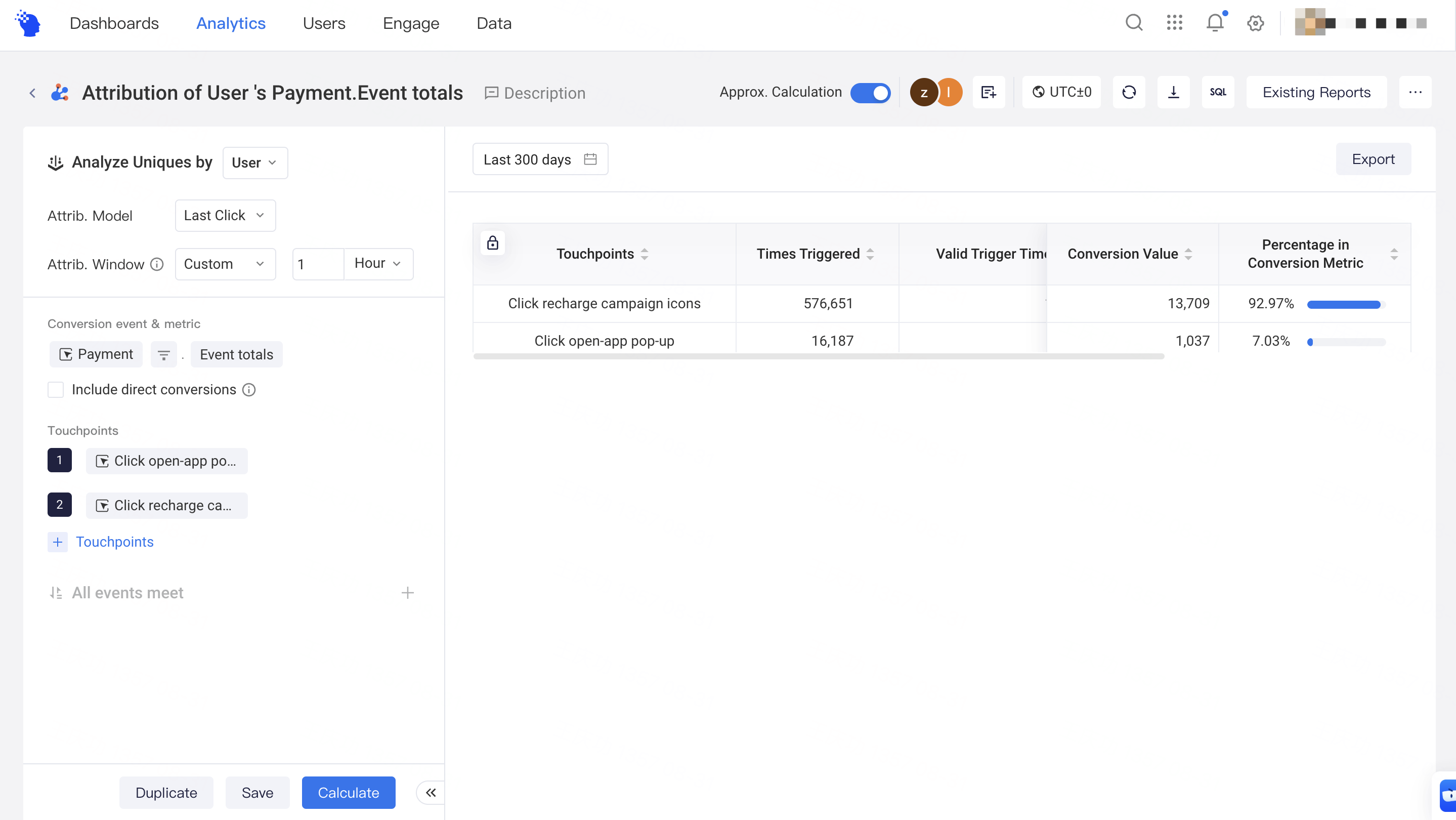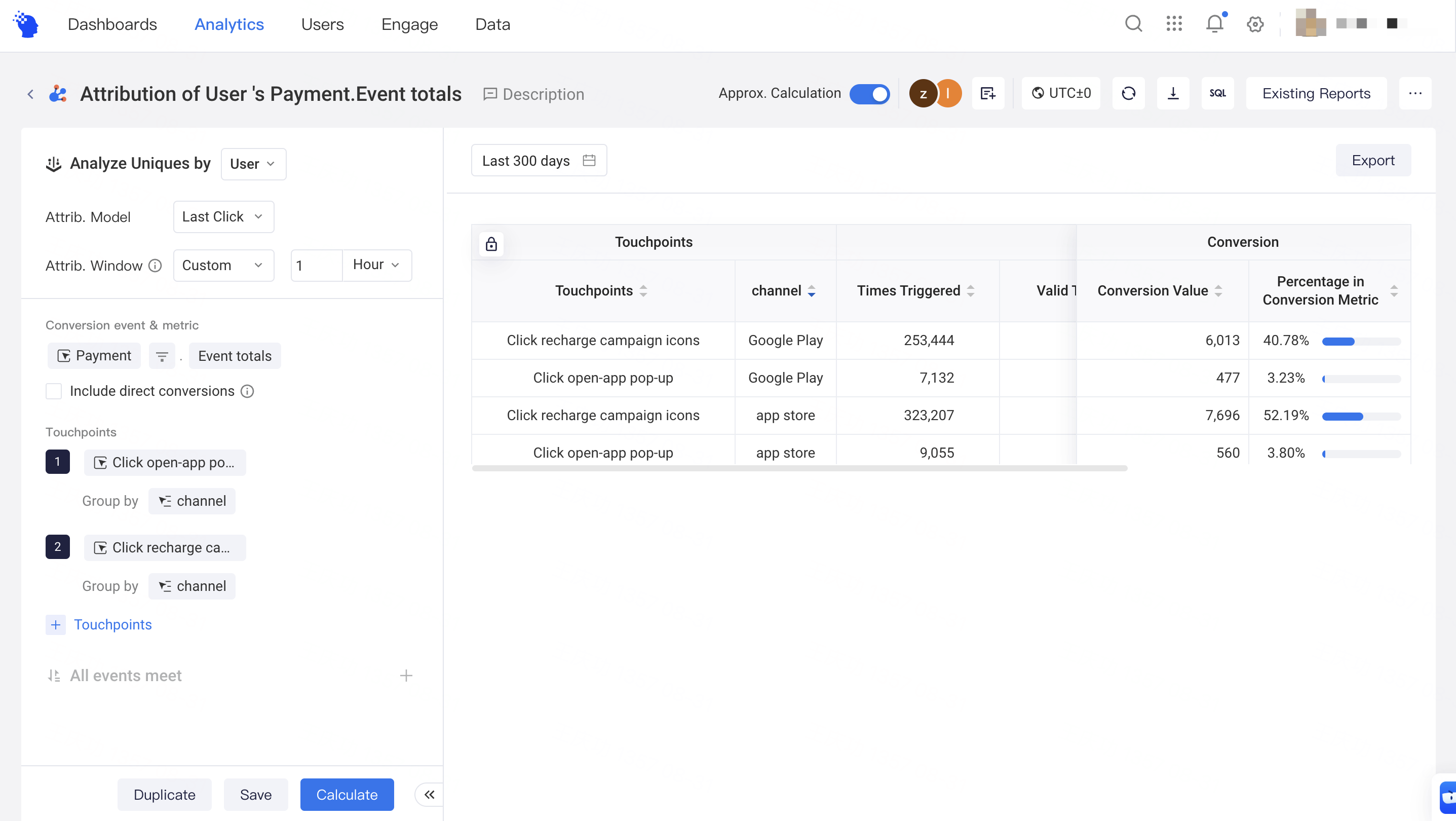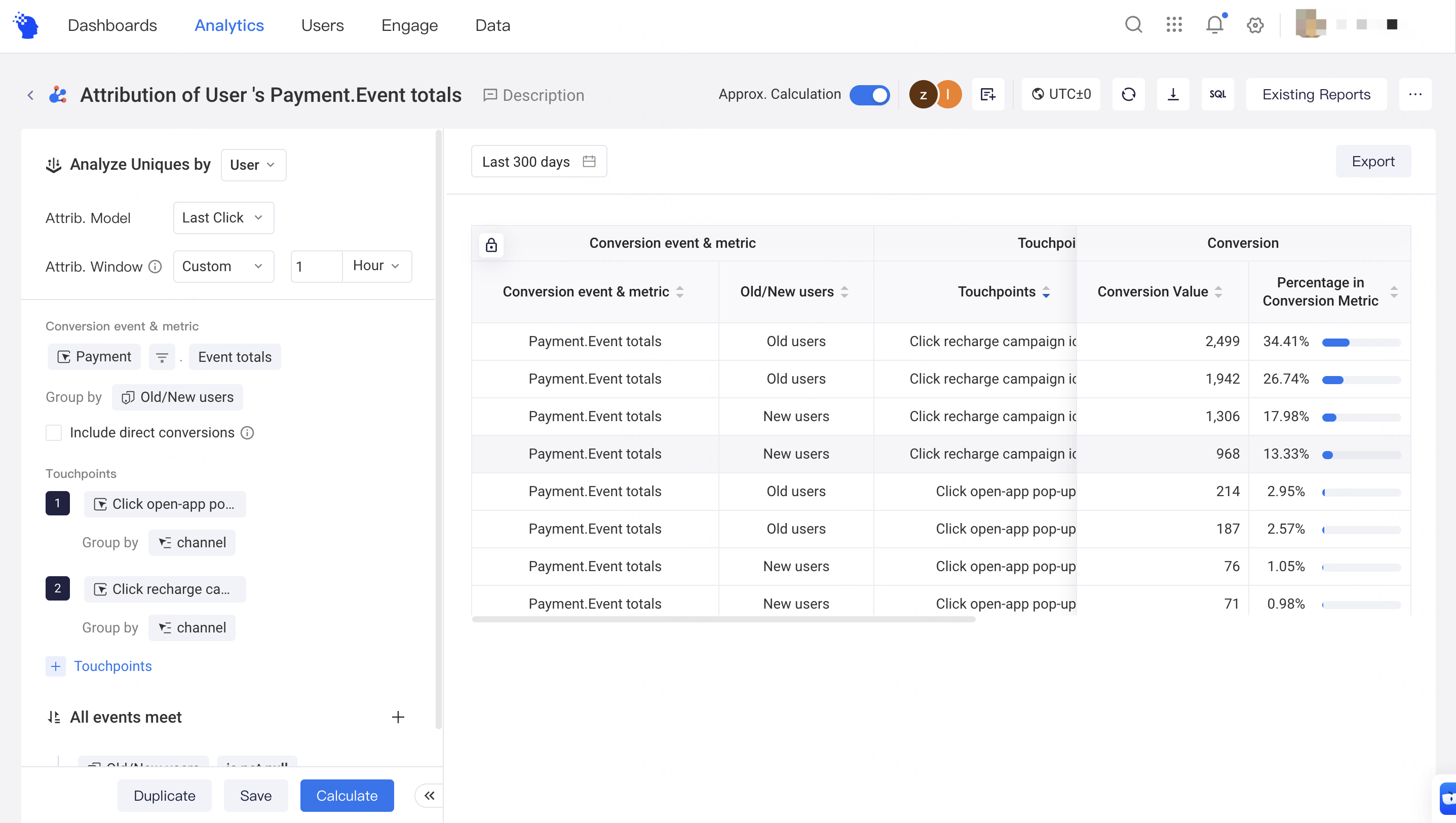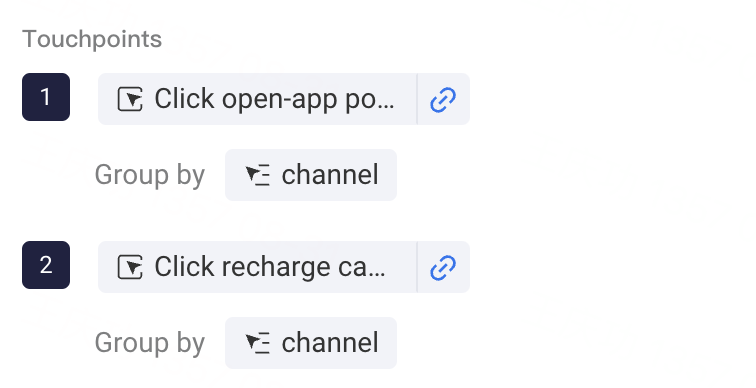# Attribution
Attribution is used to describe the contribution from each touchpoint to the conversion goal. With Attribution analysis, you can explore the contribution that resource placement brings to conversion event flexibly, as well as the ROI of these placement strategy and optimize the assignment of resources.
In Attribution analysis, you will be able to find answers to the following questions:
- How much do open-app pop-up and recharge campaign icons contribute to the recharge of your app respectively?
- How much do marketplace skin purchase and limited-time skin discount entrances contribute to diamond consumption?
- How much does losing battle and clicking the role icon each contribute to role cultivation?
# How attribution is measured
TE provides behavior-based attribution analysis in the following logic:
First, specify an Entity for the conversion behavior and touchpoint actions. Next, define your conversion goal, which includes a conversion action and a goal metric. TE seeks for all behavior within the attribution window of the conversion event from User behavior Sequence of the entity, and assigns the Conversion Value to the touchpoint based on the Attribution Model of your choice.
For example, assume that the Conversion Event C is a purchase event(C0, C1 and C2 indicate that the conversion event has occurred three times and the purchase amount is 100 for each C). Touchpoints X, Y, Z stand for the user clicking three different ads.

If the Attribution Model is First Click, then:
- the first 100 in conversion event C0 will be counted as a "Direct Conversion" since there are no touchpoints found within C0's attribution window, and C0 could be regarded as brought by organic traffic;
- the second 100 in conversion event C1 will be assigned to event X;
- the third 100 in conversion event C2 will be assigned to Y;
Thus, the Conversion Values from touchpoints X, Y, Z and from direct conversions are 100, 100, 0 and 100 respectively; X, Y, Z have each been triggered 1 time; X and Y have been triggered valid 1 time each, while Z 0 time; Valid Trigger Users for X, Y is 1 and for Z is 0.

If the Model is Last Click, then:
- the Conversion Value of C0 will be counted towards "Direct Conversion" ;
- the Conversion Value of C1 will be assigned to touchpoint Y;
- the Conversion Value of C2 will be assigned to touchpoint Z;
The Conversion Values from touchpoints X, Y, Z and from direct conversions are 0, 100, 100 and 100 respectively; X, Y, Z have each been triggered 1 time; Y, Z have been triggered valid 1 time each, while X 0 time; Valid Trigger Users for Y, Z are 1 and for X is 0.

If the Model is Linear, then:
- the first 100 from C0 will be counted towards "Direct Conversion";
- the second 100 from C1 will be evenly split to assign 50 to X and another 50 to Y;
- the third 100 from C2 will be evenly split to assign 50 to Y and another 50 to Z.
The Conversion Values from touchpoints X, Y, Z and from direct conversions are 50, 100, 50 and 100 respectively; X, Y, Z have each been triggered 1 time; X, Y, Z have each been triggered valid 1 time; valid trigger users for X, Y, Z are 1.
# Build attribution analysis reports
After you have specified the entity, the attribution window, the goal metrics and available touchpoints, you can choose to add more perspectives to your analysis using the following features:

Conversion value is assigned to touchpoints based on the attribution of your choice:
- First Click: Assign all credits to the first touch point in the attribution window.
- Last Click: Assign all credits to the last touch point in the attribution window.
- Linear: Assign credits equally to all touch points in the attribution window.
For each conversion event, there is a timeframe within which the system will look for touchpoints. The timeframe is defined by Attribution Window. You can set the Attribution Window in the following two ways:
- Same Day: The Conversion Event will seek for Touchpoints that occur not earlier than 0:00 of the day that Conversion occurs.
- Custom: The Conversion Event will seek for Touchpoints that occur in a limited time period. Day, Hour and MM are supported here.
To investigate how much credit was brought by the organic traffic besides the selected touchpoints, you can select 'Include direct conversions.' In this mode, when no touchpoint is found within the attribution window of a conversion event, the conversion value will be counted towards 'Direct conversion.'
For example, if the purchase event and coupon acqusition event are set as Conversion Event and Touchpoints respectively, the amount of money will be counted as Direct Conversion when no coupon acqusition event can be found within attribution window.
To add more dimension to your touchpoints, you may add Group-by to your touchpoints.

Moreover, to analyze the conversion brought by different cohorts, you can add Group-by to the conversion event. For example, you can check how much recharge is brought by old, versus new, users from different channels.

In situations where the conversion is only valid when touchpoints and the conversion event share a certain property value, you can use 'Hold property constant.' For example, if a conversion is measured by session, you can ensure the 'session id' found in all touchpoints and in the conversion event are identical by setting 'session id ' as the 'constant property.'


Like other analysis models, you can also add Data Filtering.
# View result metrics of Attribution
The core metric value that Attribution analysis obtains is Conversion Value. The metric definitions are listed as follows. You can acquire information about the trigger of each Touchpoints to support your decision.
| Metric | Metric Definition |
|---|---|
| Times Triggered | The total times of the occurrence of each Touchpoint within the time range*; this metric is not related to Attribution Model. |
| Valid Trigger Times | The total times of the occurrence of each Touchpoint after deemed as valid trigger based on the selected Attribution Model and Attribution Window within the time range. A touchpoint event is considered validly triggered once, even though it might have been assigned credits several times. See How attribution is measured, in Linear Attribution scenario. Touchpoint event Y, in this case, has been triggered valid for 1 time while having been attributed for 2 times. |
| Valid Rate | For each Touchpoint, Valid Trigger Times / Times Triggered. |
Valid Trigger Users | The distinct number of entities which have triggered each Touchpoint validly within the time range; the default entity is User. |
| Conversion Value | The Value of the Conversion Event that the valid trigger of each Touchpoint brings within the time range. |
| Percentage in Conversion Metric | The Conversion Value of this Touchpoint / Total Conversion Value. Please note that with all settings remaining unchanged, including "Direct Conversions" for attribution will decrease the contribution from each other touchpoints. |
*Time range: To attribute the Value of the Conversion Event as comprehensively as possible, if the attribution window is set to "Custom", the entire calculation time range is extended by an attribution window length ahead of the time range selected by time selector. If the window is set to "Same Day", the calculation time range will start from 0:00 of the start date on the time selector.
← Composition Heatmap →
